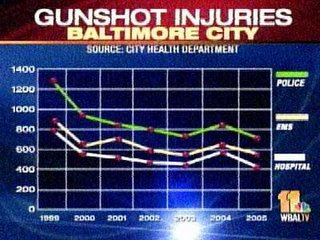An ongoing compilation of the coverage of O'Malley's use of false/misleading crime statistics."On a scale of one to 10 -- . . . 10 being the best -- how would you characterize the accuracy of the city's crime reporting since 2000? "Mayor Martin O'Malley
replies: "I would say we're somewhere north of a 9.8."
February 13, 2006 Jayne Miller of WBAL television files a
hard-hitting investigative report on how the police choose not to report some crime. Miller tells the story with three examples that seem shocking. It makes you wonder if Mayor ComStat, with all his emphasis on governing by statistics, is pressuring the police department not to report crimes to keep the statistics low for his run for Governor.
Miller begins with the story of a woman who woke up one morning in September 2005 to find her window screen cut and her purse missing. She had left her window open and her purse sitting near the window on the kitchen counter. Stupid, true, but after she called her credit card companies, she called the police. The police responded and choose not to make a report of the Burglary/Theft. Instead, the officer told the woman to get a big dog.
Burglary/Theft reported to the police, no crime report, no crime occurred according to O'Malley's system.
Miller continues with the story of a shooting in a Cherry Hill Shopping Center resulting in the victims being taken to Harbor Hospital. Miller reports that on an October 2005 afternoon, several motorists reported a gunfight in the shopping center. Moments later, Harbor Hospital ER staff make three calls to 911 to report that they have "a couple of victims of assault. . . one of them, for sure, is a gunshot victim." The police report to investigate. After requesting an incident number (which would record that a crime occurred), the officer calls back less than 90 seconds later, without explanation, and says the report was unfounded. No crime occurred according to O'Malley's crime reporting policies.
Miller interviews O'Malley's fourth hand-selected police commissioner (who has been on the job for about a year) about this incident. Commissioner Hamm says the officers were right to make no report of the shooting because the victims would not cooperate. No crime is reported because it cannot be proven it was a crime (as if the 911 calls don't show it was a crime). Even though it is unlawful to shoot a gun in Baltimore City, no crime occurred despite the fact the hospital staff say that someone suffered a gunshot wound.
A classic exchange ensues when Miller asks the Commissioner about the shooting non-incident:
What if one of these two guys died three days later?" Miller asked.
"What if they had died three days later? Then, we would have initiated an investigation. But they didn't," Hamm said.
"Do you know?" Miller asked.
"I beg your pardon?" Hamm replied.
"Do you know?" Miller asked.
"That they died?" Hamm replied. "Do you know?"
"I don't know, I'm asking you," Miller (the reporter) said.
"I don't know either, I don't know either," Hamm said.
Although you wouldn't think it was necessary, Miller consulted an expert regarding O'Malley's crime reporting policies. "Doug Ward, a retired Maryland State Police commander who spent years overseeing crime reporting by local departments, now teaches police leadership at Johns Hopkins University. ". . . it certainly raises a lot of questions in my mind," Ward said. "It's highly unusual to say it's unfounded when you have a victim in the hospital with an injury. Put it that way, it's highly unusual.""
Finally, Miller reports that one November evening in 2005, nearly a dozen 911 calls were made about a shooting where one witness heard 6 gunshots. "Police responded and located the intended target of the gunman: a man who wasn't hurt. The incident would seem to fit the definition of an aggravated assault. According to federal crime reporting guidelines, such an assault includes an unlawful attack accompanied by the use of a weapon for the purpose of inflicting severe injury. The guidelines make clear it is not necessary that injury result for an aggravated assault to occur. But in fact, Miller reported, police wrote no report at all of the . . . shooting. Instead, officers lumped it in with an armed robbery that had occurred earlier that night a couple of blocks away. . . .
So, instead of two crimes that night in south Baltimore, just one was written up, and the report on the robbery makes no mention of the shooting."WJZ-TV
reports that "Duncan called for audits of crime statistics statewide, including his own county, in order to get a better idea of how serious crime is in local jurisdictions." (Reported by Pat Warren). WBAL radio had a
similar report. WBAL radio also
picked up Doug Donovan's story in the Sun from February 11th.
